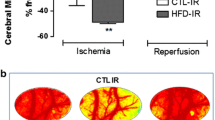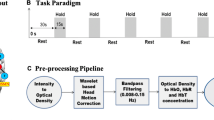Abstract
Hypertension, diabetes, obesity, and dyslipidemia are risk factors that characterize metabolic syndrome (MetS), which increases the risk for stroke by 40%. In a preliminary study, our aim was to evaluate cerebrovascular reactivity and oxygen metabolism in subjects free of vascular disease but with one or more of these risk factors. Volunteers (n = 15) 59 ± 15 (mean ± SD) years of age clear of cerebrovascular disease by magnetic resonance angiography but with one or more risk factors were studied by quantitative positron emission tomography for measurement of cerebral blood flow, oxygen consumption, oxygen extraction fraction (OEF), and acetazolamide cerebrovascular reactivity. Eight of ten subjects with MetS risk factors had OEF >50%. None of the five without risk factors had OEF >50%. The presence of MetS risk factors was highly correlated with OEF >50% by Fisher's exact test (p < 0.007). The increase in OEF was significantly (P < 0.001) correlated with cerebral metabolic rate for oxygen. Increased OEF was not associated with compromised acetazolamide cerebrovascular reactivity. Subjects with one or more MetS risk factors are characterized by increased cerebral oxygen consumption and ischemic stress, which may be related to increased risk of cerebrovascular disease and stroke.

Similar content being viewed by others
References
Abate N. Obesity and cardiovascular disease. Pathogenetic role of the metabolic syndrome and therapeutic implications. J Diab Complications. 2000;14(3):154–74. Review.
Grundy SM, Cleeman JI, Daniels SR, Donato KA, Eckel RH, Franklin BA, et al. Diagnosis and management of the metabolic syndrome. An American Heart Association/National Heart, Lung, and Blood Institute Scientific Statement. Executive summary. Cardiol Rev. 2005;13(6):322–7.
Boden-Albala B, Sacco RL, Lee HS, Grahame-Clarke C, Rundek T, Elkind MV, et al. Metabolic syndrome and ischemic stroke risk: Northern Manhattan Study. Stroke. 2008;39(1):30–5.
Arenillas JF, Moro MA, Davalos A. The metabolic syndrome and stroke. Stroke. 2007;38:2196–203.
Park K, Yasuda N, Toyonaga S, Yamada SM, Nakabayashi H, Nakasato M, et al. Significant association between leukoaraiosis and metabolic syndrome in healthy subjects. Neurology. 2007;69:974–8.
Kwon H, Kim B, Lee S, Choi S, Oh B, Yoon B. Metabolic syndrome as an independent risk factor of silent brain infarction in healthy people. Stroke. 2006;37:466–70.
Bokura H, Yamaguchi S, Iijima K, Nagai A, Oguro H. Metabolic syndrome is associated with silent ischemic brain lesions. Stroke. 2008;39:1607–09.
Kurl S, Laukkanen JR, Liskanen L, Laaksonen D, Sivenius J, Nyyssonen K, et al. Metabolic syndrome and the risk of stroke in middle-aged men. Stroke. 2006;37:806–11.
Levy AS, Chung JC, Kroetsch JT, Rush JW. Nitric oxide and coronary vascular endothelium adaptations in hypertension. Vasc Health Risk Manag. 2009;5:1075–87.
Li R, Zhang H, Wang W, Wang X, Huang Y, Huang C, et al. Vascular insulin resistance in prehypertensive rats: role of PI3-kinase/Akt/eNOS signaling. Eur J Pharmacol. 2010;628(1–3):140–7.
Knight SF, Yuan J, Roy S, Imig JD. Simvastatin and tempol protect against endothelial dysfunction and renal injury in a model of obesity and hypertension. Am J Physiol Ren Physiol. 2010;298(1):F86–94.
Aziz N, Mehmood MH, Siddiqi HS, Mandukhail SU, Sadiq F, Maan W, et al. Antihypertensive, antidyslipidemic and endothelial modulating activities of Orchis mascula. Hypertens Res. 2009;32(11):997–1003.
Török J, Koprdová R, Cebová M, Kunes J, Kristek F. Functional and structural pattern of arterial responses in hereditary hypertriglyceridemic and spontaneously hypertensive rats in early stage of experimental hypertension. Physiol Res. 2006;55 Suppl 1:S65–71.
Abarquez Jr RF. Microvascular disease relevance in the hypertension syndrome. Clin Hemorheol Microcirc. 2003;29(3–4):295–300. Review.
Nemoto EM, Yonas H, Kuwabara H, Pindzola R, Sashin D, Meltzer CC, et al. Identification of hemodynamic compromise by cerebrovascular reserve and oxygen extraction fraction in occlusive vascular disease. J Cereb Blood Flow Metab. 2004;24:1081–9.
Nemoto EM, Yonas H, Pindzola RR, Kuwabara H, Sashin D, Chang Y, et al. PET OEF reactivity for hemodynamic compromise in occlusive vascular disease. J Neuroimaging. 2007;17:54–60.
Dahl A, Russell D, Rootwelt K, Nyberg-Hansen R, Kerty E. Cerebral vasoreactivity assessed with transcranial doppler and regional cerebral blood flow measurements. Dose, serum concentration, and time course of the response to acetazolamide. Stroke. 1995;26:2302–6.
Ohta S, Meyer E, Fujita H, Reutens DC, Evans A, Gjedde A. Cerebral [15O]water clearance in humans determined by PET: I. Theory and normal values. J Cereb Blood Flow Metab. 1996;16:765–80.
Iida H, Kanno I, Miura S, Murakami M, Takahashi K, Uemura K. Error analysis of a quantitative cerebral blood flow measurement using H2 15Oautoradiography and positoron emission tomography with respect to the dispersion of the input function. J Cereb Blood Flow Metab. 1986;6:536–45.
Mintun MA, Raichle ME, Martin WRW, Herscovitch P. Brain oxygen utilization measured with O-15 radiotracerss and positron emission tomography. J Nuc Med. 1983;25:177–87.
Ohta S, Meyer E, Thompson CJ, Gjedde A. Oxygen consumption of the living human brain measured after a single inhalation of positron emitting oxygen. J Cereb Blood Flow Metab. 1992;12:179–92.
Carson RE, Huang SC, Green MV. Weighted integration method for local cerebral blood flow measurements with positron emission tomography. J Cereb Blood Flow Metab. 1986;6:245–58.
Expert Panel on Detection, Evaluation and Treatment of High Cholesterol in Adults. Executive summary of the third report of the National Cholesterol Education Program (NCEP) expert panel on the detection, evaluation, and treatment of high blood cholesterol in adults (ATP III). JAMA. 2001;486–2497.
Morrison CD. Leptin signaling in brain: a link between nutrition and cognition? Biochim Biophys Acta. 2009. doi:10.1016/j.bbadis.2008.12.004.
Villanueva EC, Myers Jr MG. Leptin receptor signaling and the regulation of mammalian physiology. Int J Obes. 2008;32:S8–10.
Shek EW, Brands MW, Hall JE. Chronic leptin infusion increases arterial pressure. Hypertension. 1998;31:409–14.
Esler M, Rumantir M, Wiesner G, Kaye D, Hastings J, Lambert G. Sympathetic nervous system and insulin resistance: from obesity to diabetes. Am J Hypertens. 2001;14:304S–9.
Masuo K, Straznicky NE, Lambert GW, Katsuya T, Sugimoto K, Rakugi H, et al. Leptin-receptor polymorphisms relate to obesity through blunted leptin-mediated sympathetic nerve activation in a caucasian male population. Hypertens Res. 2008;31:1093–100.
Straznicky NE, Eikelis N, Lambert EA, Esler MD. Mediators of sympathetic activation in metabolic syndrome obesity. Curr Hypertens Rep. 2008;10:440–7.
Bravo P, Morse S, Borne DM, Aguilar EA, Reisin E. Leptin and hypertension in obesity. Vasc Health Risk Manag. 2006;2(2):163–9.
Kazama K, Wang G, Frys K, Anrather J, Iadecola C. Angiotensin II attenuates functional hyperemia in the mouse somatosensory cortex. Am J Physiol Heart Circ Physiol. 2003;285:H1890–9.
Chu KY, Sing P, Gu L. Angiotensin II type 1 receptor antagonism mediates uncoupling protein 2-driven oxidative stress and ameliorates pancreatic islet—cell function in young type 2 diabetic mice. Antioxid Redox Signal. 2007;9:869–78.
Argiles JM, Busquets S, Lopez-Soriano F. The role of uncoupling proteins in pathophysiological states. Biochem Biophys Res Commun. 2002;293:1145–52.
Mattiasson G, Sullivan PG. The emerging functions of UCP2 in health, disease, and therapeutics. Antioxid Redox Signal. 2006;8:1–38.
Lee MY, Martin AS, Mehta PK, Dikalova AE, Garrido AM, Lyons E, et al. Mechanisms of vascular smooth muscle NADPH oxidase 1 (Nox1) contribution to injury-induced neointimal formation. Arterioscler Thromb Vasc Biol. 2009;29:00–0.
Grubb Jr RL, Derdeyn CP, Fritsch SM, Carpenter DA, Yundt KD, Videen TO, et al. Importance of hemodynamic factors in the prognosis of symptomatic carotid occlusion. JAMA. 1998;280(12):1055–60.
Garrido AM, Griendling KK. NADPH oxidases and angiotensin II receptor signaling. Mol Cell Endocrinol. 2008. doi:10.1016/j.mce.2008.11.003.
Acknowledgements
No other persons have made substantial contributions to this manuscript. This work was supported by NIH grants Nos. NS051639 and NS061216.
Author information
Authors and Affiliations
Corresponding author
Rights and permissions
About this article
Cite this article
Uchino, K., Lin, R., Zaidi, S.F. et al. Increased Cerebral Oxygen Metabolism and Ischemic Stress in Subjects with Metabolic Syndrome-Associated Risk Factors: Preliminary Observations. Transl. Stroke Res. 1, 178–183 (2010). https://doi.org/10.1007/s12975-010-0028-2
Published:
Issue Date:
DOI: https://doi.org/10.1007/s12975-010-0028-2




